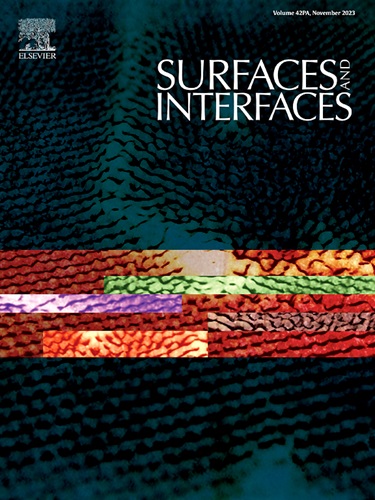水动力空化技术制备水溶性ZnS量子点及其稳定性研究
IF 5.7
2区 材料科学
Q2 CHEMISTRY, PHYSICAL
引用次数: 0
摘要
本研究采用“自上而下”的方法,采用流体动力空化(HC)技术大规模制备了ZnS量子点(QDs)。这些ZnS量子点具有粒径小(1.75 nm)、粒径分布范围窄(1.0 ~ 3.0 nm)、荧光量子产率高(37.45%)等优点,具有广阔的应用前景。然而,量子点溶液的稳定性在其实际应用中至关重要,因此系统地研究了表面改性以提高ZnS量子点溶液的稳定性。研究了温度、时间、pH值和不同表面改性剂(L-cys、TGA、PEG和TPT)对ZnS量子点光学性质的影响。实验结果表明,在低温、弱碱和黑暗条件下,ZnS量子点在溶液中不易团聚,且ZnS量子点溶液在贮存6周后仍保持较高的荧光强度。此外,ZnS量子点的表面改性可以显著提高其在水溶液中的稳定性和溶解度。在365 nm紫外光照射2.0 h下,ZnS QDs溶液的荧光强度仍保持在原值的80%左右。这些实验结果为ZnS量子点的合成条件优化和实际应用提供了重要的理论依据和实践指导。本文章由计算机程序翻译,如有差异,请以英文原文为准。
Preparation of water-soluble ZnS quantum dots by hydrodynamic cavitation technology and related stability exploration
In this study, ZnS quantum dots (QDs) were prepared on a large-scale by hydrodynamic cavitation (HC) technology using the method of "top to bottom". These ZnS QDs have the advantages of small particle size (1.75 nm), narrow size distribution range (1.0–3.0 nm) and high fluorescence quantum yield (37.45 %), which show wide application potential. However, the stability of QDs solution is crucial in their practical application, so the surface modification is systematically studied for enhancing the ZnS QDs solution stability. The effects of temperature, time, pH value and different surface modifiers (L-cys, TGA, PEG and TPT) on the optical properties of ZnS QDs were investigated. The experimental results show that ZnS QDs are not easy to agglomerate in solution under the conditions of low temperature, weak alkali and dark conditions, and the fluorescence intensity of ZnS QDs solution remains high after six weeks of storage. In addition, the surface modification of ZnS QDs can significantly improve their stability and solubility in aqueous solution. Under 365 nm ultraviolet lamp irradiation for 2.0 h, the fluorescence intensity of ZnS QDs solution still maintained about 80 % of its original value. These experimental results provide an important theoretical basis and practical guidance for the optimization of synthesis conditions and practical application of ZnS QDs.
求助全文
通过发布文献求助,成功后即可免费获取论文全文。
去求助
来源期刊

Surfaces and Interfaces
Chemistry-General Chemistry
CiteScore
8.50
自引率
6.50%
发文量
753
审稿时长
35 days
期刊介绍:
The aim of the journal is to provide a respectful outlet for ''sound science'' papers in all research areas on surfaces and interfaces. We define sound science papers as papers that describe new and well-executed research, but that do not necessarily provide brand new insights or are merely a description of research results.
Surfaces and Interfaces publishes research papers in all fields of surface science which may not always find the right home on first submission to our Elsevier sister journals (Applied Surface, Surface and Coatings Technology, Thin Solid Films)
 求助内容:
求助内容: 应助结果提醒方式:
应助结果提醒方式:


